Related Research Articles

Agriculture encompasses crop and livestock production, aquaculture, fisheries, and forestry for food and non-food products. Agriculture was the key development in the rise of sedentary human civilization, whereby farming of domesticated species created food surpluses that enabled people to live in cities. While humans started gathering grains at least 105,000 years ago, nascent farmers only began planting them around 11,500 years ago. Sheep, goats, pigs, and cattle were domesticated around 10,000 years ago. Plants were independently cultivated in at least 11 regions of the world. In the 20th century, industrial agriculture based on large-scale monocultures came to dominate agricultural output.

Rural flight is the migratory pattern of people from rural areas into urban areas. It is urbanization seen from the rural perspective.
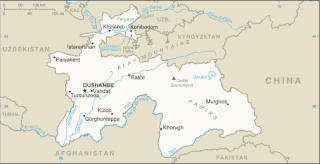
Tajikistan is nestled between Kyrgyzstan and Uzbekistan to the north and west, China to the east, and Afghanistan to the south. Mountains cover 93 percent of Tajikistan's surface area. The two principal ranges, the Pamir Mountains and the Alay Mountains, give rise to many glacier-fed streams and rivers, which have been used to irrigate farmlands since ancient times. Central Asia's other major mountain range, the Tian Shan, skirts northern Tajikistan. Mountainous terrain separates Tajikistan's two population centers, which are in the lowlands of the southern and northern sections of the country. Especially in areas of intensive agricultural and industrial activity, the Soviet Union's natural resource utilization policies left independent Tajikistan with a legacy of environmental problems.
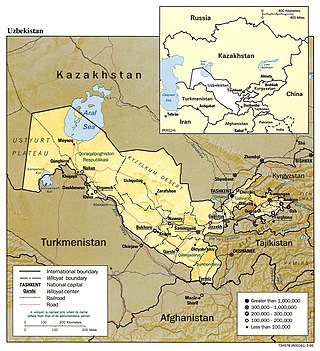
Uzbekistan is a country in Central Asia, located north of Turkmenistan and Afghanistan. With an area of approximately 447,000 square kilometers, Uzbekistan stretches 1,425 km (885 mi) from west to east and 930 km (580 mi) from north to south. It borders Turkmenistan to the southwest, Kazakhstan to the north and Tajikistan and Kyrgyzstan to the south and east. Uzbekistan also has four small exclaves in Turkmenistan.

The one-child policy was a population planning initiative in China implemented between 1979 and 2015 to curb the country's population growth by restricting many families to a single child. The program had wide-ranging social, cultural, economic, and demographic effects, although the contribution of one-child restrictions to the broader program has been the subject of controversy. Its efficacy in reducing birth rates and defensibility from a human rights perspective have been subjects of controversy.

A dust storm, also called a sandstorm, is a meteorological phenomenon common in arid and semi-arid regions. Dust storms arise when a gust front or other strong wind blows loose sand and dirt from a dry surface. Fine particles are transported by saltation and suspension, a process that moves soil from one place and deposits it in another.

Organic farming, also known as ecological farming or biological farming, is an agricultural system that uses fertilizers of organic origin such as compost manure, green manure, and bone meal and places emphasis on techniques such as crop rotation and companion planting. It originated early in the 20th century in reaction to rapidly changing farming practices. Certified organic agriculture accounts for 70

Conservation agriculture (CA) can be defined by a statement given by the Food and Agriculture Organization of the United Nations as "Conservation Agriculture (CA) is a farming system that can prevent losses of arable land while regenerating degraded lands.It promotes minimum soil disturbance, maintenance of a permanent soil cover, and diversification of plant species. It enhances biodiversity and natural biological processes above and below the ground surface, which contribute to increased water and nutrient use efficiency and to improved and sustained crop production."

Kentville is an incorporated town in Nova Scotia. It is the most populous town in the Annapolis Valley. As of 2021, the town's population was 6,630. Its census agglomeration is 26,929.
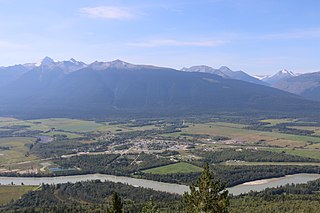
McBride is a village in the Robson Valley region of British Columbia, Canada. The village is located 210 km (130 mi) southeast of Prince George, British Columbia, and 166 km (103 mi) west of Jasper, Alberta. Incorporated in 1932, McBride is located in the Robson Valley surrounded by the Rocky Mountains and Cariboo Ranges.
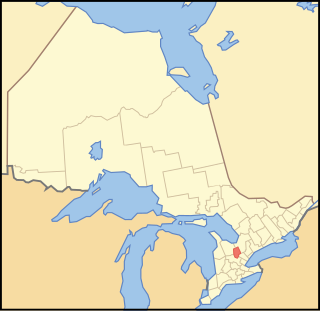
Dufferin County is a county and census division located in Central Ontario, Canada. The county seat is Orangeville, and the current Warden is Wade Mills. The current chief administrative officer is Sonya Pritchard. Dufferin covers an area of 1,486.31 square kilometres (573.87 sq mi), and its population was 61,735 at the time of the 2016 Census.

Environmental degradation is the deterioration of the environment through depletion of resources such as quality of air, water and soil; the destruction of ecosystems; habitat destruction; the extinction of wildlife; and pollution. It is defined as any change or disturbance to the environment perceived to be deleterious or undesirable. The environmental degradation process amplifies the impact of environmental issues which leave lasting impacts on the environment.
A green economy is an economy that aims at reducing environmental risks and ecological scarcities, and that aims for sustainable development without degrading the environment. It is closely related with ecological economics, but has a more politically applied focus. The 2011 UNEP Green Economy Report argues "that to be green, an economy must not only be efficient, but also fair. Fairness implies recognizing global and country level equity dimensions, particularly in assuring a Just Transition to an economy that is low-carbon, resource efficient, and socially inclusive."
Human overpopulation describes a concern that human populations may become too large to be sustained by their environment or resources in the long term. The topic is usually discussed in the context of world population, though it may concern individual nations, regions, and cities.

The middle of the 20th century was marked by a significant and persistent increase in fertility rates in many countries of the world, especially in the Western world. The term baby boom is often used to refer to this particular boom, generally considered to have started immediately after World War II, although some demographers place it earlier or during the war. This terminology led to those born during this baby boom being nicknamed the baby boomer generation.
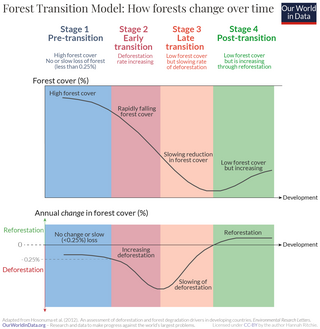
Forest transition refers to a geographic theory describing a reversal or turnaround in land-use trends for a given territory from a period of net forest area loss to a period of net forest area gain. The term "landscape turnaround" has also been used to represent a more general recovery of natural areas that is independent of biome type.

China primarily produces rice, wheat, potatoes, tomato, sorghum, peanuts, tea, millet, barley, cotton, oilseed, corn and soybeans.
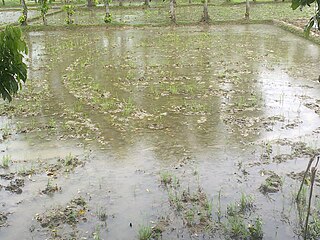
Agricultural land is typically land devoted to agriculture, the systematic and controlled use of other forms of life—particularly the rearing of livestock and production of crops—to produce food for humans. It is generally synonymous with both farmland or cropland, as well as pasture or rangeland.
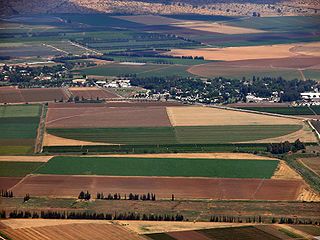
Biodiversity in agriculture is the measure of biodiversity found on agricultural land. Biodiversity is the total diversity of species present in an area at all levels of biological organization. It is characterized by heterogeneous habitats that support the diverse ecological structure. In agricultural areas, biodiversity decreases as varying landscapes are lost and native plants are replaced with cultivated crops. Increasing biodiversity in agriculture can increase the sustainability of farms through the restoration of ecosystem services that aid in regulating agricultural lands. Biodiversity in agriculture can be increased through the process of agroecological restoration, as farm biodiversity is an aspect of agroecology.

Environmental issues in the United Arab Emirates (UAE) are caused by the exploitation of natural resources, rapid population growth, and high energy demand. The continuing temperature rise caused by global warming contributes to UAE's water scarcity, drought, rising sea level, and aridity. The UAE has a hot desert climate, which is very vulnerable to the effects of climate change and contributes to worsening water scarcity, quality, and water contamination.
References
- 1 2 Sandström, Vilma; Saikku, Laura; Antikainen, Riina; Sokka, Laura; Kauppi, Pekka (15 April 2014). "Changing impact of import and export on agricultural land use: The case of Finland 1961–2007". Agriculture, Ecosystems & Environment. 188: 163–168. Bibcode:2014AgEE..188..163S. doi:10.1016/j.agee.2014.02.009.
- 1 2 Charles Geisler; Ben Currens (20 December 2013). ""Peak Farmland": Revealed Truth or Recreancy?". William R. Freudenburg, A Life in Social Research. Research in Social Problems and Public Policy. Vol. 21. Emerald Group Publishing Limited. pp. 177–199. doi:10.1108/s0196-1152(2013)0000021012. ISBN 978-1-78190-734-4.
- ↑ "What is peak farmland?". Kate Prengaman. 8 January 2013. Archived from the original on 24 October 2016. Retrieved 24 October 2016.
- ↑ Sandström, Vilma; Saikku, Laura; Antikainen, Riina; Sokka, Laura; Kauppi, Pekka (15 April 2014). "Changing impact of import and export on agricultural land use: The case of Finland 1961–2007". Agriculture, Ecosystems & Environment. 188: 163–168. Bibcode:2014AgEE..188..163S. doi:10.1016/j.agee.2014.02.009.
- 1 2 ""Peak farmland" is here, crop area to diminish: study". Reuters. 17 December 2016. Retrieved 18 October 2016.
- ↑ Poore, Joseph (January 2016). "Call for conservation: Abandoned pasture". Science. 351 (6269): 132. Bibcode:2016Sci...351..132P. doi:10.1126/science.351.6269.132-a. PMID 26744398.
- ↑ "The Return of Nature – How Technology Liberates the Environment". thebreakthrough.org. Retrieved 24 October 2016.
- 1 2 Johan Norberg (1 September 2016). Progress: Ten Reasons to Look Forward to the Future. Oneworld Publications. p. 236. ISBN 978-1-78074-951-8.
- 1 2 Robert Bryce (13 May 2014). Smaller Faster Lighter Denser Cheaper: How Innovation Keeps Proving the Catastrophists Wrong. PublicAffairs. p. 151. ISBN 978-1-61039-206-8.
- ↑ "Are We Close to Peak Farmland? | Conservancy Talk". Conservancy Talk. 22 January 2013. Archived from the original on 24 October 2016. Retrieved 24 October 2016.
- ↑ Jesse H. Ausubel, Peak Farmland, Lecture for the 18 December 2012 Symposium in Honor of the 80th Birthday of Paul Demeny and his retirement as editor of Population and Development Review